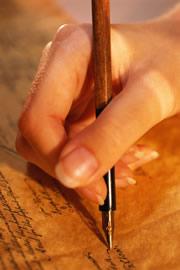 Old documents are falling apart thanks to corrosive inks.© Punchstock
Old documents are falling apart thanks to corrosive inks.© PunchstockScientists have discovered a way to slow the disintegration of old manuscripts.
The technique involves bathing papers in an organic solution doped with alkali compounds and antioxidants. These help to tie up atoms of copper and other metals in the ink that may eat the paper away.
It is the first successful treatment that is not water-based, the researchers announced at the annual conference of the British Association for the Advancement of Science in Dublin on 5 September. This means it can be applied to documents without fear of washing away soluble scribbles, causing books to swell or ruining leather bindings.
The researchers, who have applied for a patent, say the bath could help to protect kilometres of ancient documents and manuscripts throughout the world's libraries for many years to come. They think it should be ready for commercial use in a few years' time.
Holey papers
Conservators have long known that there is something corrosive about inks from the Middle Ages. Many documents, from sketches by famous artists to political treaties, have fallen apart over time, with holes appearing where the ink used to be.
To tackle this problem, Jana Kolar, head of the InkCor project based at the National and University Library of Slovenia in Ljubljana, and her colleagues sought to uncover the exact constituents of the inks.
Early analyses had indicated that medieval inks are often full of iron. Free atoms of this metal in the ink react with the air to create oxygen radicals, reactive atoms that break down cellulose, yellowing paper and making it brittle. To the horror of scholars, after hundreds of years this can cause the paper to fall apart.
Copper tone
Kolar and her team noticed that some ancient recipes specified that the ink should be a "heavenly blue" rather than coal black. So they suspected that the main ingredient could be copper, from blue copper sulphate, rather than iron.
They investigated by bombarding old inks with protons, and analysing the X-rays emitted from the samples. Sure enough, the inks contained copper, as well as chromium and manganese, which together are more corrosive than iron alone. "This was an important finding," says Kolar.
They turned their focus to free radical scavengers and antioxidants, the same compounds that stop cellular damage in humans by tying up particularly reactive atoms.
Suck it up
One of Kolar's collaborators, Han Neevel at the Netherlands Institute for Cultural Heritage in Amsterdam, had previously used one such comound to stop the corrosive process of iron in old inks. But this compound, known as phytate, is metal-specific and so cannot be used with all inks from the old days. And the phytate process has the disadvantage of being water-based.
The InkCor process combines antioxidants and halides, to stop the degradation, with alkalies to make the paper less acidic. The whole thing is in an organic solution of heptane and ethanol, both of which evaporate and so can be removed from paper easily.
ADVERTISEMENT
Kolar declined to give the meeting all the details of her recipe. But she says the treatment can increase the lifespan of some ancient papers by more than ten times.
"The results of the laboratory tests look promising," says Robien van Gulik, head of paper conservation in the Dutch Teylers Museum in Haarlem.
The team says it will next try to apply the method to other materials, such as leather and silk. These too have highly corrosive colour pigments that can decompose over time.
